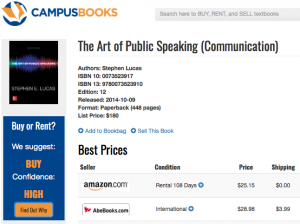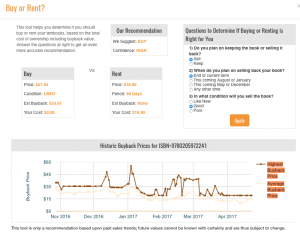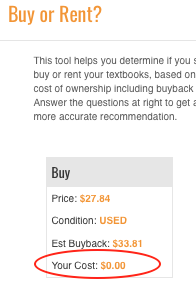In Textbook Buyback: Getting the Most Money (Part 1), we covered basics such as comparison shopping for the highest buyback offers, reading the fine print, following textbook buyback rules and best practices, and avoiding the campus bookstore.
Now in Part 2, we’ll go deeper and show you how putting in a little more work can basically lead to incredibly cheap textbooks or books that actually make you money to buy, use, and sell. Think of it like the stock market and investing; it’s all about timing and buying low and selling high.
Bigger Bucks at Buyback: Here’s How It Works
You don’t have to be an Econ. major to understand supply and demand. Bottom line: the more available something is, the less valuable it is and thus, the cheaper it is to buy; the more scarce a resource, the more expensive. What happens at textbook buyback? Students form a long line to turn over the same books as everybody else in line and many students in many lines at many colleges. ALL AT THE SAME TIME. The market is flooded, which is why that clerk at the bookstore tells you that your book gets you $3 back or the bookstore isn’t even buying it.
A quick note here: there’s other stuff at work such as new editions coming out that replace existing editions, professors not knowing which books they will use the next semester thus leaving the bookstore not knowing which books to stock, etc. But let’s stick to what we know, namely that in December and May right after finals, students sell their books back and that creates a surplus, which devalues the textbooks.
And Here’s What You Can Do

What can you do about this? Well, you can’t control what other people do or what bookstores pay or when semesters end, but with a little knowledge, foresight, and patience, you can hang onto your books a little longer and likely sell them for more cash back when the market isn’t saturated with too many copies.
Step 1: Know when to buy textbooks and know when to rent textbooks. This was kind of a crapshoot until we came up with the CampusBooks.com Buy Vs. Rent SuperBot, which uses historical and predictive data to give you the total cost of ownership for any textbook.  What’s total cost of ownership? That’s what it costs you to get the book and use it, whether that’s buying it and selling it back or renting it and returning it. Sometimes it’s cheaper to rent, sometimes it’s cheaper to buy and sell back, and now you can know and make smart money decisions rather than guess and take a costly hit.
What’s total cost of ownership? That’s what it costs you to get the book and use it, whether that’s buying it and selling it back or renting it and returning it. Sometimes it’s cheaper to rent, sometimes it’s cheaper to buy and sell back, and now you can know and make smart money decisions rather than guess and take a costly hit.
Step 2: For books you rented, just get them back on time and in good condition. For books you bought and do not want to keep, sell them when they are the most in demand and most valuable, namely in late August and early January. Straight up: that is when buyback prices are the highest because the books are in the greatest demand (because it’s back to school time and buyers need your books so they can sell them to other students). Get it? Sell your textbooks when everyone else is buying them and you’ll get top dollar, sometimes enough so that the total cost of ownership was nothing (free textbooks!) or to make a little money.


